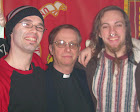
Part Two
This lesson plan exists as an isolated element, for inclusion either within Dance 309, or as the basis for a possible class in Gay Film, ideally at the college, or through, perhaps, The Learning Connection. If used with the dance course, it could be used as is, or modified by adding clips of Carmencita, Little Egypt and Annabelle Whitford's Serpentine Dances. As the opening for a college dance class, it would be an introduction to later films, 1904-1920, of which there are very few.
Alice Guy Blache's Algie The Miner (1912) is probably the earliest film with an identifiably gay character. There are a number of cross-dressing films in which straight actors played women for purposes of humour. Charlie Chaplin, Fatty Arbuckle, Stan Laurel, Wallace Beery and others all tried their hand at these rôles. Sometimes professional female impersonators were used, as Boothwell Brown in 1919's Yankee Doodle in Berlin. During the 1920's, many more gay characters and gay milieus were filmed.
Different From the Others, made in Germany by Richard Oswald and Magnus Hirschfeld, was the first of a number of German films dealing with gay people and gay themes. There is a significant gay subtext in Fred Niblo's Ben-Hur, and Salome (1923) is reputed to have been produced entirely with gay actors and technical staff. Discussion of immorality in films led to the imposition of the motion Picture Production Code, which banned gay people from film, except for the "sissy" which remained the standard portrayal of gay people until after World War II.
From 1944's Laura on, gay people begin to become more visible, but with also, a dark and sinister quality. During the 1950's we see a loosening, including the appearance of Kenneth Anger's first films, the appearance of more gay characters, or gay actors, such as Rock Hudson trying to look straight. By the 1960's the Code has been overthrown, but gay people are still being shown in a negative light. After Stonewall, it seems that visibility is very much increased, but gay people always seem to suffer for being gay, as in Boys in the Band.
It is not until the mid 1980's that gay people seem to be relatively normal, and often funny. Later films deal with gay people in ordinary ways, but also allegorical depictions of gay problems, as in The Wolves of Kromer. By 2000, gay characters have been largely accepted into the mainstream, and gay directors examine social problems related to being gay, such as Elephant (2003). This lays out a very general approach to such a course, but detailed lesson plans have yet to be written.
Here follows the plan for the introductory The Gay Brothers:
The Gay Brothers This video is designed to establish a discussion about early gay film, and to look critically at both film and criticism. Vito Russo, while first to examine gay film, sometimes lacks scholastic rigour. Russo seems to have let his agenda outstrip his ability as a researcher. Video is not always able to carry information with the same - depth or intensity as lecture or written material. In this video, the intertitles are kept deliberately simple for this reason. In addition, language use itself needed to be carefully crafted for simplicity. The short nature of the films selected, in most cases being 50 feet or under dictated that the video be very short. The Dickson Experimental Film, is the oldest surviving dance film; it has also been called the oldest gay film, on questionable authority.
Objectives
1. Critical consideration of gay content in Dickson's film.
2. Review of other contemporary films with possible gay. content.
Activity 1: Showing of The Gay Brothers video.
Activity 2: Discussion of films.
The Dickson film was never released to the public. Its purpose was solely to test the feasibility of synchronising image and sound. There is no evidence that the men on the film are brothers, or that they are gay. The music is the "Song of the Cabin Boy", from Les Cloches de Corneville, composed by Robert Planquette in 1877. The lyrics celebrate a life at sea with no women, but the Dickson film is merely an instrumental. The title The Gay Brothers seems to have originated with Russo himself.
Is this, as Vito Russo claims, the first gay film?
What are features of the film are, or may be gay?
What suggests that it may not be gay?
Discussion of other films: Sandow, Princess Ali, Dewar's and The Old Maid Having Her Picture Taken.
What gives Eugen Sandow's film gay interest?
What can we say about Princess Ali?
Is Dewar's a gay film? Is something else involved?
Can you tell on first viewing the film, that Gilbert Saroney is a female impersonator?
What do you think is the first gay film?

No comments:
Post a Comment